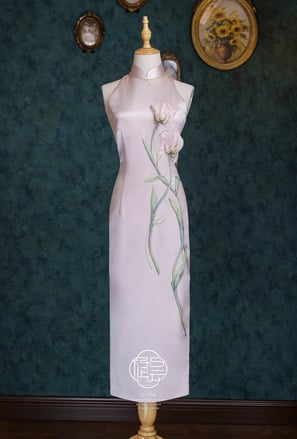What's the difference between a cheongsam and a Qipao
"Cheongsam" and "Qipao" are two terms for the same traditional Chinese dress, yet they differ in linguistic roots, historical context, style, and cultural symbolism.
QIPAO KNOWLEDGE
6/4/20252 min read


Linguistic Origins
Cheongsam: Derived from the Cantonese pronunciation of "长衫" as "cheu hng saam", meaning long clothing. It is commonly used in Cantonese - speaking regions such as Hong Kong and Guangdong, as well as in overseas Chinese communities. Later, it was adopted by the English language and has become a common international term for the traditional Chinese dress.
Qipao: It is the Pinyin transliteration of the Mandarin Chinese term for the dress. It is the standard term used in Mandarin - speaking environments in mainland China, as well as in formal settings and academic literature. This term better reflects the close connection of the dress with traditional Chinese culture.
Historical Development Emphasis
Cheongsam: In the early 20th century, Shanghai, as a fashion hub at that time, was influenced by Western culture and modified the traditional Manchu dress. The modified dress was called "Cheongsam", emphasizing its fashionability and modernity. In terms of tailoring, it fits the female body curves more closely to showcase a woman's figure. It also incorporates many Western fashion elements, such as lace and frills.
Qipao: It places more emphasis on its historical roots. It originated from the long robes worn by Manchu women during the Qing Dynasty. In the Qing Dynasty, Qipao styles were relatively loose, focusing on covering the body curves, reflecting the traditional aesthetics and cultural concepts of that era.
Stylistic and Detail Variations
Cheongsam: It has a lower neckline to show the female neck line. The overall length is generally above or below the knee, with higher slits, usually reaching the middle of the thigh or even higher, which can show the female leg line. There are many variations in sleeves, including short sleeves, sleeveless, and three - quarter sleeves, which are more in line with modern fashion and daily wear needs.
Qipao: The traditional Qipao has a high neckline that completely covers the neck, giving a sense of dignity and conservativeness. The length is generally longer, mostly floor - length or reaching the ankles. The slits are relatively low, usually below the knee, and long sleeves are mainly used, which can better reflect the solemnity and elegance of traditional clothing.
Cultural Connotation Expression
Cheongsam: Due to its wide application and development in the modern fashion field, Cheongsam more often represents an image of fashion and elegance. It frequently appears in fashion shows, banquets, parties and other occasions, and is an important garment to showcase female charm and fashion taste. It has also become an important symbol of the exchange and integration of Chinese culture and world fashion culture.
Qipao: It carries rich traditional Chinese cultural connotations, representing China's ancient clothing culture, aesthetic concepts, and national spirit. It often appears in important cultural events, traditional festivals, weddings and other occasions, and serves as an important carrier for inheriting and promoting traditional Chinese culture.
The terms "Cheongsam" and "Qipao" essentially refer to the same traditional Chinese dress, representing different linguistic expressions of the same garment in various language environments. However, there are also some subtle differences, as detailed below:


